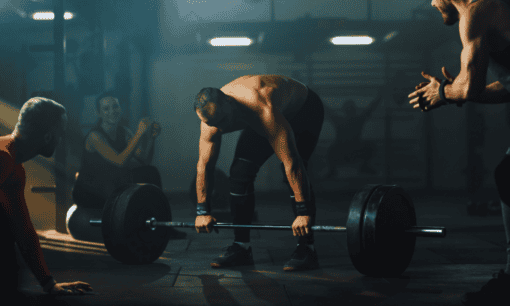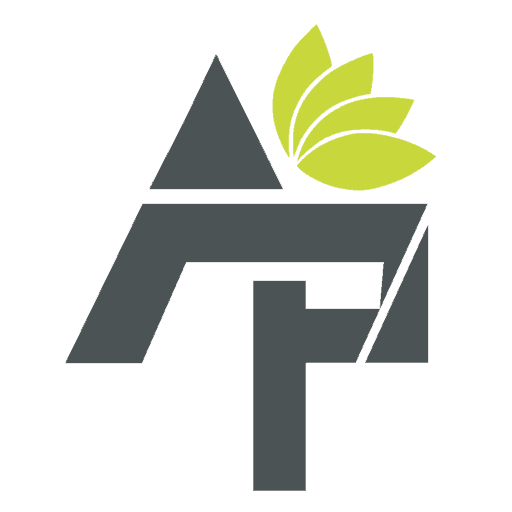Topic Contents
The ISSA Powerlifting Instructor Course
The ISSA Powerlifting Instructor Course is a course designed to help you become an expert in bench, squat, and deadlift. It is a specialization course, which means it is technically designed for people who are already certified personal trainers, as a way to add Specialties to their coaching.
That said, it gives information on much more than powerlifting moves. An entirely online course, I was surprised at how applicable the content was to other aspects of training, even groups like seniors and those in recovery. But what’s included, and is it worth the cost?
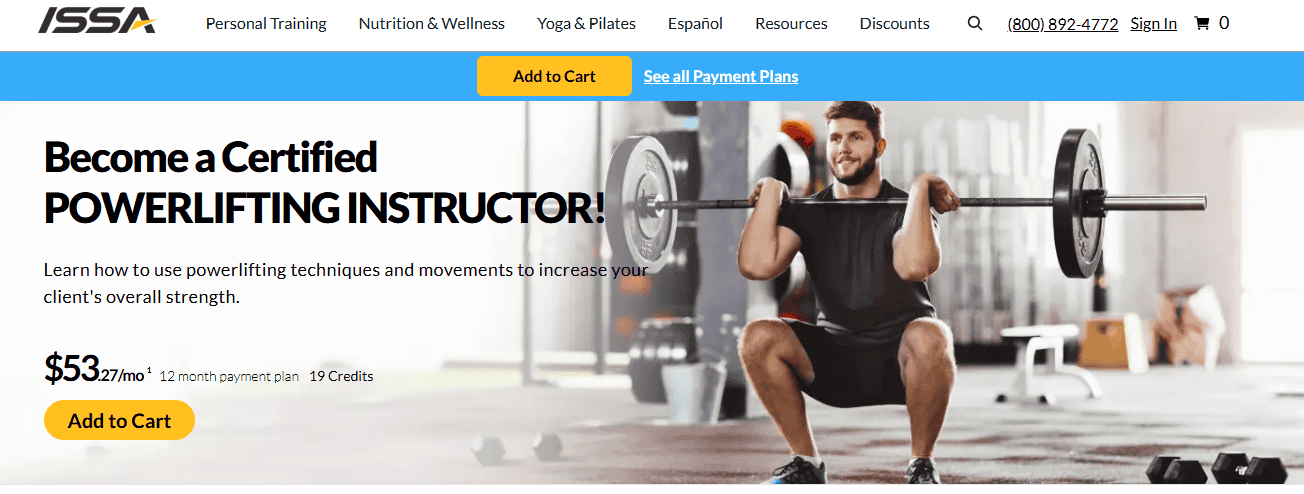
Cost
- Around $640
What’s Included in the Cost
- Entirely online curriculum
- Personalized dashboard that tracks your progress and shows individual, weekly modules
- Content broken down into weekly recommended “modules”
- Video lessons in addition to text content
- Open-book quizzes after each module
- Online, open-book exam (you get two attempts to pass)
Who Should Consider the ISSA Powerlifting Instructor Course?
- CPTs who want to add a powerlifting specialization for clients interested in strength development
- Coaches who train athletes who might want to improve strength or compete
- Experienced powerlifters who want to gain more knowledge about biometrics
CE Credits
- 19 credits–If you have any other certification and you need continuing education units to keep your certification current, this course is a single credit shy of meeting that need
What I Love
- Very detailed information in each chapter
- Associated program building data
What I Don’t Love
- How limited the text is compared to other courses
Curriculum

This program is designed for coaches who want to specialize in powerlifting for their clients. The information included is regularly updated, so you can trust that each time you sign up for a course, it has the more current science behind practices and innovations.
Included in the text are things like:
- Fundamentals of powerlifting movements
- How to teach clients safe, effective powerlifting form
- How to evaluate and assess the foundation of your clients
- How to instruct correct form in clients
- How to create programs tailored to abilities and increase strength in clients
All in, this course is, as to be expected, heavily centered on powerlifting techniques and improvements.
Course Content

The ISSA powerlifting instructor course is designed like many of their courses: with online videos, images, and reading material. Each module is laid out with different chapters, and for each chapter, there are associated reading assignments, videos, and quizzes.
At the end of it all, you take your final exam (open book, untimed) online, at your convenience. If you don’t pass (at 70% or higher), you can take it again for free, but if you don’t pass a second time, you have to pay a retake fee.
Application of Course Content
So how relevant is this course to, say, someone who works mostly with people in their 50s or who works part time as a certified yoga instructor?
Surprisingly relevant.
Though this course, based on the name, seems like it would only apply to those who work with powerlifters, I was surprised at how relevant the information was for all coaches. I, for example, work with a mother and daughter. The mother has several health complaints and prior injuries, while the daughter has limited mobility. Included in their chest day workouts are, of course, chest presses, and in their leg/back days, squats and deadlifts.
When I first started, I didn’t think twice about the complexity of those movements because I grew up around them. But as soon as I started coaching them, I had moments where I watched clients and thought “Why are you moving like that? Did I explain it incorrectly?” and in the case of some, yes, I did, and in the case of others, it was something like tightness in hips for people who had never previously worked out their hips.
So I had to adapt, change their routines at the start to build up those powerlifting moves. This actually included a lot of yoga and stretching, as well as free weight based movements like squats.
When I added this course, I was surprised that it helped me with those types of clients by teaching me how to more effectively coach them so they didn’t injure themselves but still improved.
Pros:
- It is highly accessible, with a self-paced, fully online course structure, perfect for people with text anxiety or who have busy schedules and might have different hours of availability from week to week.
- Covers the fundamentals of powerlifting like program design, nutrition, and exercise science.
- Has a lot of career and business guidance that other certifications from other organizations do not.
- Has a lot of fitness bundling options, so if you are beginning and want to bring down costs, you can bundle multiple courses.
Cons:
- Because it is entirely online, the course lacks a lot of in-person workshops or hands-on training, which can be a challenge at first.
- Unlike other certs, ISSA is not accredited by the National Commission for Certifying Agencies (NCCA). That does not, in any way, mean you won’t be able to use your certs, but it’s something to know.
- If you want to work with high-level competitive athletes, there are better certs like the CSCS or NSCA.
- If you want to better understand the competitive powerlifting field, the cert from USA Powerlifting is more appropriate.
Study Aids
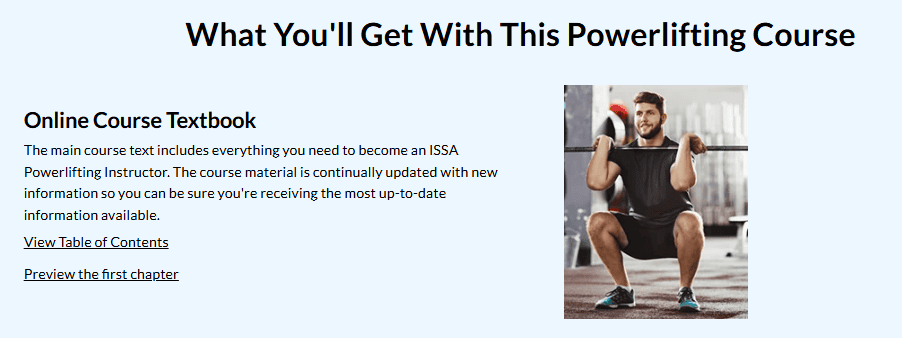
Study aids come with each course, including this one. For the powerlifting course, you can access study aids like the Hyperstrike Exercise Videos, a collection of videos showing hundreds of exercises from different angles so you know how to safely teach them to your clients.
You also get access to the bookstore, where you can purchase hard copies of all the available textbooks. The downside here is this particular book isn’t available for hardcover purchase at this time, but you can buy complementary books to assist in your career as a coach, like finances for coaching and motivation.
Course Length
The course is designed with 31 modules, spread out over a recommended 11 week program. As it is entirely online and self-paced, you can go slower than this if you need.
The content builds off previous chapters, starting with things like:
- Powerlifting Basics for Personal Training
- The Basics
- Kinesiology
- Biomechanics
- Exercise Physiology
- Assessment Basics
- Technique
- Program Design
- Suggested Warm-up and Stretching Protocols
The chapters are robust, covering all application topics to powerlifting success like anatomy, physiology, biomechanics, exercise science, and nutrition.
Tip: Not sure about the course yet? They let you preview the first chapter online so that might help you see the layout and structure.
Continuing Education Credits
I will say, one thing I don’t like is that this course counts for 19 continuing education credits. So if you are looking for a complementary coaching course to not only improve your offerings to clients, but you need to meet your renewal credits, this course gets you so close to the finish you can touch it–but can’t grab it.
And ISSA doesn’t offer a lot of 1 unit courses, so that’s going to mean taking yet another course, or enrolling in a webinar or something. Feels a lot like college, where you ended up with half or single credit courses (that were somehow 10 hours of work per week) but needed to still have 3 credits in that area.
Career Support
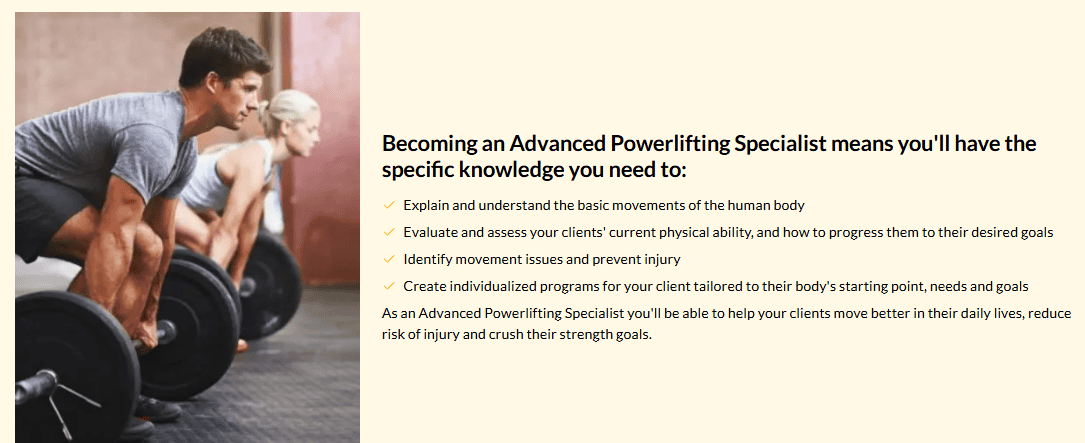
As you work your way through the program, you get (and continue to have after completion) access to career support tools.
These include:
- Business cards
- Business guide step-by-step
- Use of the ISSA-certified logo
- A free website
- Trainer PDF forms
- Personal health coverage
- Access to a medical fitness network
- Liability insurance
All of these resources are available as long as you keep your certification current. What’s more, you have access to a job site where you can apply for real jobs in your area for powerlifting coaches and other fitness jobs.
Key Skills
After taking this course, you learn some key skills that may or may not benefit your practice.
- The first skill is program design. This teaches you how to create individualized programs for your clients, incorporating powerlifting routines. There are printables included with the course content that can help with this.
- The second skill is form correction. With this, you can watch clients and identify errors with form and help correct their technique (wish I had this when I started training that mother-daughter duo; had to bring in another coach to help me figure out what the issue was).
- You also learn client assessment skills, where you can evaluate a client during an initial consultation and from there create a personalized plan for them to reach their fitness goals.
- Finally, you get a pretty robust knowledge of biomechanics, understanding how the body moves with these movements and why, for example, it’s so important to bring the shoulder blades in during a press or how training a deadlift with heeled shoes or on a wedge can help.
Limitations

All that said, the ISSA Powerlifting Instructor course isn’t without its limitations. It is, by design, a very generalized strength specialty. That means it is ideal for coaches whose clients might want to add powerlifting training to their routine, but not necessarily fitness pros who want to get into competitions with their clients.
If you are looking to train competitive powerlifters, then the USAPL cert is more your style because it focuses on the rules and strategies your clients would need at competitions.
Summing Up
With this course, you can become an expert in powerlifting, starting from the science of the human body to understanding how to assess current physical ability and prevent injury. By the end of the course, you’ll know how to create individualized programs for clients that help them reach fitness goals.
Alt Protein Team is a team of professionals and enthusiasts committed to bringing you the most up-to-date information on alternative protein, health and wellness, workouts, and all things health-related. We’ve reviewed a lot of products and services so you don’t have to guess when you spend your hard-earned money on them. Whether you want to shed some pounds, build lean muscle or bulk, we can help you figure out what you need to do and what you need to have to achieve your goals.

